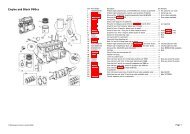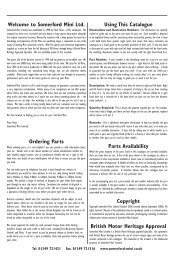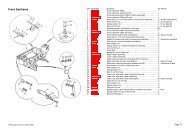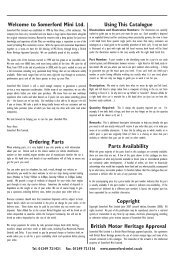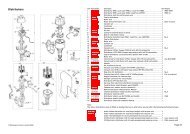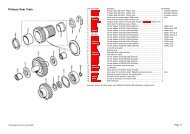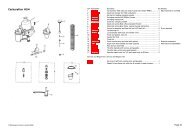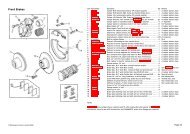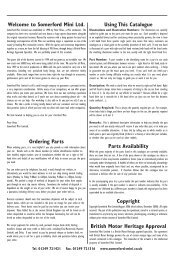Performance
Performance
Performance
- No tags were found...
You also want an ePaper? Increase the reach of your titles
YUMPU automatically turns print PDFs into web optimized ePapers that Google loves.
Bristol 0117 923 2523 Manchester 0161 480 6402 IDENTIFICATION 11<br />
*Note: This crankshaft was used in all 1275cc, A+, transverse engines including the MG Metro<br />
Turbo. There are various unconfirmed opinions on the subject of whether the material was any<br />
different, or whether it was heat treated differently. It would appear that early Turbos had just the<br />
standard spec, EN16T, non-heat treated type fitted. Later examples certainly appear to have been<br />
heat-treated, probably an up-to-date, emissions-friendly version of ‘Tuftriding’ (a recognised ICI<br />
registered process) - possibly a forerunner to Nitro-Carburising. These crankshafts have a<br />
distinctly charcoal-grey/black finish - mostly detectable on the webs, water pump/alternator pulley<br />
end and in the rolled fillet radii. The later being fairly ‘deep’ and very even.<br />
Car Identification<br />
Compression ratio is hugely important to an engines performance, work out your compression ratio<br />
and the combustion chamber volume you need, make sure the head you are buying - especially if<br />
its of the shelf - has the right volume. David Vizards book ‘Tuning the a series engine’ has<br />
invaluable information in it concerning this.<br />
Valve sizes are no guarantee of flow, just because it has big valves does not mean it flows big,<br />
take a valve out and look into the port, the guide should be bullet nosed, and is the seat<br />
unnecessarily wide, maybe a wide ‘pre cut’ to the seat Are the seats cut accurately for height,<br />
run your fingers across inlet and exhaust differences - are they the same for all the chambers<br />
Engine Numbers<br />
The engine number is located immediately<br />
above the alternator.<br />
Cars Produced Up To 1979<br />
The commission number can be found on a<br />
red plate fitted to the bonnet slam panel.<br />
Look down into the ports, is there a raised section around the guide (a boss), all our heads have these<br />
removed for full flow is the finish consistent across all the ports, and not highly polished - a polished<br />
finish can actually reduce power due to fuel being drawn out of the air, due to surface tension.<br />
Hold a suitable gasket up to the manifold and chamber faces, have the chambers and ports been<br />
accurately modified Usually on cheaply modified heads the ports are flared out to meet the gasket<br />
giving the appearance but not performance.<br />
Cylinder Head Casting Numbers<br />
Number Inlet Dia. Exhaust Dia. Nom. cc Standard fitment<br />
2A628 1.0625”/26.99 1.00”/25.4 24.5 850, 998 Mini & 948 Sprite<br />
2A629 1.0625”/26.99 1.00”/25.4 24.5 948, A35 & Morris Minor<br />
12A1456 1.0625”/26.99 1.00”/25.4 24.5 850, 998 Mini & 948 Sprite<br />
12G202 1.156”/29.36 1.00”/25.4 26.1 997 Cooper, Austin 1100 Mk<br />
CAM4180 1.0625”/26.99 1.00”/25.4 25.5 998 Mini A+ (80 on) & lead free<br />
12G206 1.218”/30.93 1.00”/25.4 28.3 Early 998 Cooper, MG1100<br />
12G295 1.218”/30.93 1.00”/25.4 28.3 998 Cooper, MG1100<br />
12A185 1.401”/35.6 1.22”/31.0 21.4 First MkI Cooper S<br />
AEG163 1.401”/35.6 1.22”/31.0 21.4 Later MkI & MkII Cooper S<br />
12G940* 1.312”/33.33 1.15”/29.2 21.4 1275GT, Austin 1300, late A+<br />
model inc. Turbo not MG Metro<br />
12G940 1.401”/35.6 1.15”/29.2 21.4 12G1805 Stamped on flat<br />
area by thermostat MG1300,<br />
1300GT & MkIII Cooper S<br />
12G940* 1.401”/35.6 1.15”/29.2 21.4 as above plus MG Metro<br />
Cars Produced Between 1980-84<br />
In 1980 the use of the vehicle identification<br />
numbers was introduced. The V.I.N. plate<br />
is located on the left hand flitch, in front of<br />
the radiator.<br />
Cars Produced After 1984<br />
The V.I.N. plate can be found fitted to the right<br />
hand flitch, near the bonnet prop locating<br />
bracket.<br />
*Note: A+ head castings - despite having the same 12G940 casting number - are considerably<br />
different in appearance, loosing the flat area behind the thermostat housing and around the rest of<br />
the rocker/head stud areas to a sculptured look - where these areas are replaced by a ‘sunken’ cast<br />
finish. The A+ castings were introduced with the appearance of the Metro in 1980, although some<br />
late 1275GTs 1979-On had them fitted. Generally they are easily recognised by their colour - a putrid<br />
yellow on the small-bore castings and bright red on the large-bore ones, a paint finish that is VERY<br />
difficult to remove, even in a chemical tank. The MG Metro Turbo shares the same valve sizes with<br />
the other non-’big valve’ 12G940 variants but has 8mm valve stems, sodium-filled exhaust valves.<br />
A+ heads generally have three collet grooves in the valves, collets are 14-degree cone taper<br />
instead of the 10-degree on single groove collets (so parts are not interchangeable) and the topcaps<br />
have a raised ridge around the collet hole.<br />
For the latest prices, please visit www.moss-europe.co.uk



